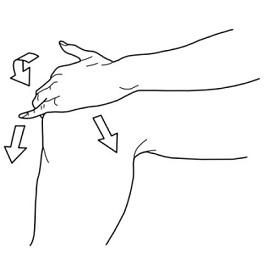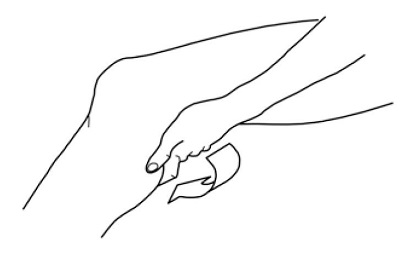SPL MEDGUIDE
| Medication Guide for Nonsteroidal Anti-inflammatory Drugs (NSAIDs)
|
|
| What is the most important information I should know about medicines called Nonsteroidal Anti-inflammatory Drugs (NSAIDs)?
NSAIDs can cause serious side effects, including: ● Increased risk of a heart attack or stroke that can lead to death. This risk may happen early in treatment and may increase:
Avoid taking NSAIDs after a recent heart attack, unless your healthcare provider tells you to. You may have an increased risk of another heart attack if you take NSAIDs after a recent heart attack. ● Increased risk of bleeding, ulcers, and tears (perforation) of the esophagus (tube leading from the mouth to the stomach), stomach and intestines: o anytime during use o without warning symptoms o that may cause death The risk of getting an ulcer or bleeding increases with:
|
|
| NSAIDs should only be used:
○ exactly as prescribed ○ at the lowest dose possible for your treatment ○ for the shortest time needed |
|
| What are NSAIDs?
NSAIDs are used to treat pain and redness, swelling, and heat (inflammation) from medical conditions such as different types of arthritis, menstrual cramps, and other types of short-term pain. |
|
| Who should not take NSAIDs?
Do not take NSAIDS:
|
|
Before taking NSAIDs, tell your health care provider about all of your medical conditions, including if you:
|
|
| What are the possible side effects of NSAIDs?
NSAIDs can cause serious side effects, including: See "What is the most important information I should know about medicines called Nonsteroidal Anti-inflammatory Drugs (NSAIDs)?"
|
|
|
|
|
|
| |
| Stop taking your NSAID and call your health care provider right away if you get any of the following symptoms:
|
|
|
|
|
|
|
|
|
|
|
|
| |
| If you take too much of your NSAID, call your health care provider or get medical help right away.
These are not all the possible side effects of NSAIDs. For more information, ask your health care provider or pharmacist about NSAIDs. Call your doctor for medical advice about side effects. You may report side effects to FDA at 1-800-FDA-1088. |
|
Other information about NSAIDs
|
|
| General information about the safe and effective use of NSAIDs
Medicines are sometimes prescribed for purposes other than those listed in a Medication Guide. Do not use NSAIDs for a condition for which it was not prescribed. Do not give NSAIDs to other people, even if they have the same symptoms that you have. It may harm them. If you would like more information about NSAIDs, talk with your health care provider. You can ask your pharmacist or health care provider for information about NSAIDs that is written for health professionals. |
|
| Manufactured for: Alembic Pharmaceuticals, Inc. Bedminster, NJ 07921, USA Manufactured by: Alembic Pharmaceuticals Limited (Derma Division), Karakhadi, Vadodara 391450, India. Mfg. License no.: G/25/2216 For more information, go to www.alembicusa.com or call 1-866-210-9797. |
|
This Medication Guide has been approved by the U.S. Food and Drug Administration Revised: 01/2024
Diclofenac Sodium (dye kloe' fen ak soe' dee um) Topical Solution, 2%
Read the Medication Guide that comes with diclofenac sodium topical solution first. Be sure that you read, understand and follow these Instructions for Use before you use diclofenac sodium topical solution for the first time.
Important: For use on the skin only (topical). Do not get diclofenac sodium topical solution in your eyes, nose or mouth.
Before you use diclofenac sodium topical solution:
- Apply diclofenac sodium topical solution exactly as your healthcare provider tells you. Talk with your healthcare provider or pharmacist if you are not sure.
- Only use diclofenac sodium topical solution to treat pain from osteoarthritis in your knee or knees.
- Apply diclofenac sodium topical solution on clean, dry skin that does not have any cuts, infections or rashes.
- Use diclofenac sodium topical solution two times a day on your knee or knees as prescribed.
- If you get diclofenac sodium topical solution in your eyes, rinse your eyes right away with water or saline. Call your healthcare provider if your eyes are irritated for more than one hour.
Diclofenac sodium topical solution comes in a pump bottle from your healthcare provider.
If you are using a diclofenac sodium topical solution pump bottle follow the steps below:
Before you use diclofenac sodium topical solution pump bottle for the first time, you will need to prime the pump. To prime the pump, remove the cap (See Figure A) and fully press the top of the pump all the way down 4 times while holding the bottle in an upright position (See Figure B). Dispense this portion of the medicine into a tissue or paper towel and throw it away in a trash can. The pump is now ready to use. You should not need to prime the pump again.


Steps for using diclofenac sodium topical solution pump bottle:
Step 1: Wash your hands with soap and water before applying diclofenac sodium topical solution.
Step 2: Remove the bottle cap and press the pump head down firmly and fully to dispense diclofenac sodium topical solution into the palm of your hand. Release the pump head and then press the pump head down firmly and fully a second time. When you use your diclofenac sodium topical solution pump bottle, you can hold the bottle at an angle. Put 2 pumps of diclofenac sodium topical solution on your hand (See Figure C).

Step 3: Apply diclofenac sodium topical solution evenly around the front, back, and sides of your knee. Diclofenac sodium topical solution should be applied without massaging the knee (See Figures D and E).


Step 4: Repeat Steps 2 and 3 for your other knee if your healthcare provider has prescribed diclofenac sodium topical solution for both knees.
Step 5: Wash your hands with soap and water right away after applying diclofenac sodium topical solution.
Step 6: Replace the cap on the bottle and store in an upright position.
After you use diclofenac sodium topical solution:
Do not:
- cover your knee with clothing until your knee is completely dry.
- put sunscreen, insect repellant, lotion, moisturizer, cosmetics, or other topical medicines on your knee until it is completely dry.
- take a shower or a bath for at least 30 minutes after you put diclofenac sodium topical solution on your knee(s).
- use heating pads or cover the treated area with bandages where you have applied diclofenac sodium topical solution.
- exercise following application of diclofenac sodium topical solution.
- use sunlamp and tanning beds. Protect your treated knee from sunlight. Wear clothes that cover your skin if you have to be in the sunlight.
How should I store diclofenac sodium topical solution?
- Store diclofenac sodium topical solution at room temperature between 68°F to 77°F (20°C to25°C).
Keep diclofenac sodium topical solution and all medicines out of the reach of children.
This Instructions for Use has been approved by the U.S. Food and Drug Administration.
The brand names mentioned are registered trademarks of their respective manufacturers.
Manufactured for:
Alembic Pharmaceuticals, Inc.
Bedminster, NJ 07921, USA
Manufactured by:
Alembic Pharmaceuticals Limited
(Derma Division),
Karakhadi, Vadodara 391450, India.
Mfg. License no.: G/25/2216
Revised: 01/2024